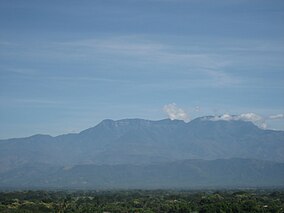Sierra de Perijá National Park,also known asPerijá National Park(Spanish:Parque Nacional Sierra de Perijá) is aprotected areain westernVenezuela,in theSerranía de Perijámountains, on the border withColombia.[1]The national park, located southwest ofZuliastate andLake Maracaibo,was established in 1978 with the objective of protecting thebiodiversityof the hilly regions.[2]
| Sierra de Perijá National Park Perijá National Park | |
|---|---|
 Perijá National Park | |
| Location | Venezuela |
| Nearest city | Maracaibo |
| Coordinates | 9°32′0″N73°0′0″W/ 9.53333°N 73.00000°W |
| Area | 295,288 hectares (729,670 acres) |
| Established | 1978 |
| Governing body | Instituto Nacional de Parques(INPARQUES) ’’National Park Institute’’ |
Geography
editSierra de Perijá National Park is in thePerijaandColonmunicipalities of Zulia State. The park is accessible by road fromMaracaibo.[1]
The park includes a portion of the Serranía de Perijá mountains,[3]which rises above the southwestern area ofLake Maracaibo,a large brackish bay connected to theGulf of Venezuela.The highest elevation isPico Tétarat 3,500 metres (11,500 ft).[1]It covers an area of 295,288 hectares (729,670 acres).[4]
Flora and fauna
editThe vegetation in the park consists mainly ofrainforest,cloud forests,highland moors and somesub-alpineandalpine tundra.[1]TypicalspeciesoftreesincludeAnacardium excelsum,the wax palmsCeroxylon,Cecropia,Gyranthera caribensis,Tabebuia chrysantha,T. billbergii,T. chryseaandPodocarpus oleifolius,as well as countlessherbaceousandflowering plants,epiphyticand viningaroids,ferns,mosses,lichens,carnivorous plants,tropicalcactiandbromeliads.[5][6]Aquatic plant species are varied, as well, includingEchinodorus,
Fauna in the park is varied, and includes some largercarnivoresandomnivores,such as the rarespectacled bear(Tremarctos ornatus—the only extant bear species found in South America). Iconic South American mammals include thered-rumped agouti(Dasyprocta leporina),lesser capybara(Hydrochoerus isthmius),giant anteater,northern tamandua,paca,and largerfelids,including thepumaor South American mountain lion (Felis c. concolor) and theocelot(Leopardus pardalis). Rare, but potential, sightings ofjaguar(Panthera onca) andjaguarundi(Felis yagouaroundi) can occur. These predators typically stalk the region's small nativedeer,including theAmazonian brown brocket(Mazama nemorivaga), thecommon red brocket(Mazama americana) and thelittle red brocket(Mazama rufina), as well as thecollared peccary(Tayassu angulatus), a wild relative ofpigs.Primatesinclude theColombian red howler(Alouatta seniculus),grey-handed night,varied capuchin(Cebus versicolor) andlong-haired spider monkeys(Ateles hybridus).[1]Guiana dolphins(Sotalia guianensis) living inLake Maracaiboare proposed to be included under a protection program through theSouth American River DolphinProtected Area Network.[2]
Birds are many, and include parrot species such as the well-known andendangeredmilitary macaw(Ara militaris),[7]as well as manyhummingbirds,including the endangeredPerijá metaltail(Metallura iracunda)[8]andCoeligena consita,anendemicspecies of the southern Sierra de Perijá.[9]A newlydescribed speciesoftapaculofound in the park is thePerijá tapaculo(Scytalopus perijanus), first formally described in 2015.[10]
Threats
editUncontrolled fires and deforestation are major threats to the natural ecosystems in the park.[11]
References
edit- ^abcde"Perijá".think-venezuela.net. Archived fromthe originalon 3 March 2016.Retrieved1 September2015.
- ^abHoyt 2012,p. 240.
- ^Dallmeier & Cringan 1989,p. 300.
- ^"National Parks of Venezuela".World Institute for Conservation & Environment.Retrieved1 September2015.
- ^IUCN Directory of Neotropical Protected Areas.IUCN. 1982. pp. 381–.ISBN978-0-907567-62-2.
- ^Soto Villalobos, José Alberto; Ferrer-Paris, José R.; Sanchez-Mercado, Ada; Grande, Jose Ramón; Cardozo-Urdaneta, Arlene; Vargas, Thayma (2016)."Sinopsis del género Tabebuia s.l. (Angiospermae: Bignoniaceae) en el estado Zulia, Venezuela".Figshare.doi:10.6084/m9.figshare.3081088.v1.Retrieved2 July2016.
- ^"Endangered and Threatened Wildlife and Plants; Two Foreign Macaw Species".Federal Register: Daily Journal of the United States Government.Retrieved1 September2015.
- ^"EN:Perija Metaltail Metallura iracunda".Birdlife International.Retrieved1 September2015.
- ^"VU:Perija Starfrontlet Coeligena consita".Birdlife International.Retrieved1 September2015.
- ^"Perijá Tapaculo: New Bird Species Discovered in Colombia, Venezuela".Sci-News. 12 March 2015.Retrieved1 September2015.
- ^Ferrer-Paris, José R. (2016)."Ubicación de los Incendios en la Sierra de Perijá, estado Zulia Venezuela, entre enero 2015 y marzo 2016".Figshare.doi:10.6084/m9.figshare.3116761.Retrieved2 July2016.
Bibliography
edit- Dallmeier, Francisco Gomez; Cringan, Alexander T. (1989).Biology, Conservation and Management of Waterfowl in Venezuela.Editorial Ex Libris.ISBN978-980-6200-13-5.
- Hoyt, Erich (2 October 2012).Marine Protected Areas for Whales, Dolphins and Porpoises: A World Handbook for Cetacean Habitat Conservation and Planning.Routledge.ISBN978-1-136-53830-8.
External links
edit- Media related toSierra de Perijá National Parkat Wikimedia Commons
